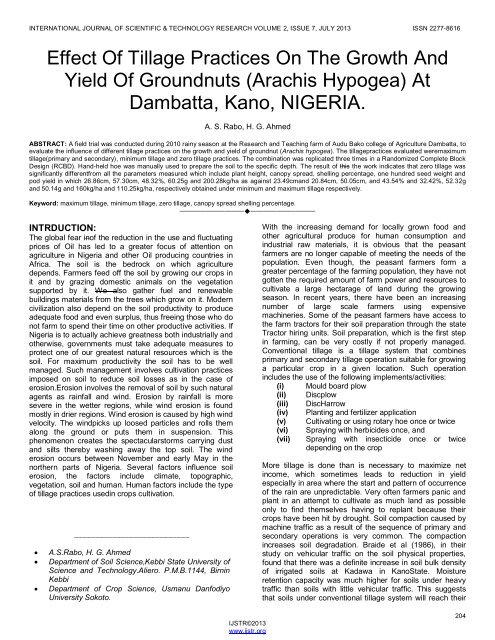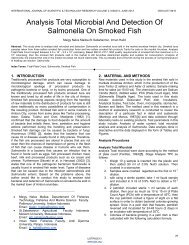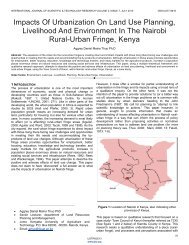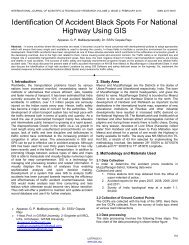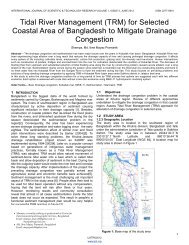Effect Of Tillage Practices On The Growth And Yield Of Groundnuts
Effect Of Tillage Practices On The Growth And Yield Of Groundnuts
Effect Of Tillage Practices On The Growth And Yield Of Groundnuts
You also want an ePaper? Increase the reach of your titles
YUMPU automatically turns print PDFs into web optimized ePapers that Google loves.
INTERNATIONAL JOURNAL OF SCIENTIFIC & TECHNOLOGY RESEARCH VOLUME 2, ISSUE 7, JULY 2013 ISSN 2277-8616<strong>Effect</strong> <strong>Of</strong> <strong>Tillage</strong> <strong>Practices</strong> <strong>On</strong> <strong>The</strong> <strong>Growth</strong> <strong>And</strong><strong>Yield</strong> <strong>Of</strong> <strong>Groundnuts</strong> (Arachis Hypogea) AtDambatta, Kano, NIGERIA.A. S. Rabo, H. G. AhmedABSTRACT: A field trial was conducted during 2010 rainy season at the Research and Teaching farm of Audu Bako college of Agriculture Dambatta, toevaluate the influence of different tillage practices on the growth and yield of groundnut (Arachis hypogea). <strong>The</strong> tillagepractices evaluated weremaximumtillage(primary and secondary), minimum tillage and zero tillage practices. <strong>The</strong> combination was replicated three times in a Randomized Complete BlockDesign (RCBD). Hand-held hoe was manually used to prepare the soil to the specific depth. <strong>The</strong> result of this the work indicates that zero tillage wassignificantly differentfrom all the parameters measured which include plant height, canopy spread, shelling percentage, one hundred seed weight andpod yield in which 26.86cm, 57.30cm, 48.32%, 60.25g and 200.28kg/ha as against 23.49cmand 20.84cm, 50.05cm, and 43.54% and 32.42%, 52.32gand 50.14g and 160kg/ha and 110.25kg/ha, respectively obtained under minimum and maximum tillage respectively.Keyword: maximum tillage, minimum tillage, zero tillage, canopy spread shelling percentage.————————————————————INTRDUCTION:<strong>The</strong> global fear inof the reduction in the use and fluctuatingprices of Oil has led to a greater focus of attention onagriculture in Nigeria and other Oil producing countries inAfrica. <strong>The</strong> soil is the bedrock on which agriculturedepends. Farmers feed off the soil by growing our crops init and by grazing domestic animals on the vegetationsupported by it. We also gather fuel and renewablebuildings materials from the trees which grow on it. Moderncivilization also depend on the soil productivity to produceadequate food and even surplus, thus freeing those who donot farm to spend their time on other productive activities. IfNigeria is to actually achieve greatness both industrially andotherwise, governments must take adequate measures toprotect one of our greatest natural resources which is thesoil. For maximum productivity the soil has to be wellmanaged. Such management involves cultivation practicesimposed on soil to reduce soil losses as in the case oferosion.Erosion involves the removal of soil by such naturalagents as rainfall and wind. Erosion by rainfall is moresevere in the wetter regions, while wind erosion is foundmostly in drier regions. Wind erosion is caused by high windvelocity. <strong>The</strong> windpicks up loosed particles and rolls themalong the ground or puts them in suspension. Thisphenomenon creates the spectacularstorms carrying dustand silts thereby washing away the top soil. <strong>The</strong> winderosion occurs between November and early May in thenorthern parts of Nigeria. Several factors influence soilerosion, the factors include climate, topographic,vegetation, soil and human. Human factors include the typeof tillage practices usedin crops cultivation.___________________________A.S.Rabo, H. G. AhmedDepartment of Soil Science,Kebbi State University ofScience and Technology.Aliero. P.M.B.1144, BirninKebbiDepartment of Crop Science, Usmanu DanfodiyoUniversity Sokoto.With the increasing demand for locally grown food andother agricultural produce for human consumption andindustrial raw materials, it is obvious that the peasantfarmers are no longer capable of meeting the needs of thepopulation. Even though, the peasant farmers form agreater percentage of the farming population, they have notgotten the required amount of farm power and resources tocultivate a large hectarage of land during the growingseason. In recent years, there have been an increasingnumber of large scale farmers using expensivemachineries. Some of the peasant farmers have access tothe farm tractors for their soil preparation through the stateTractor hiring units. Soil preparation, which is the first stepin farming, can be very costly if not properly managed.Conventional tillage is a tillage system that combinesprimary and secondary tillage operation suitable for growinga particular crop in a given location. Such operationincludes the use of the following implements/activities:(i) Mould board plow(ii) Discplow(iii) DiscHarrow(iv) Planting and fertilizer application(v) Cultivating or using rotary hoe once or twice(vi)(vii)Spraying with herbicides once, andSpraying with insecticide once or twicedepending on the cropMore tillage is done than is necessary to maximize netincome, which sometimes leads to reduction in yieldespecially in area where the start and pattern of occurrenceof the rain are unpredictable. Very often farmers panic andplant in an attempt to cultivate as much land as possibleonly to find themselves having to replant because theircrops have been hit by drought. Soil compaction caused bymachine traffic as a result of the sequence of primary andsecondary operations is very common. <strong>The</strong> compactionincreases soil degradation. Braide et al (1986), in theirstudy on vehicular traffic on the soil physical properties,found that there was a definite increase in soil bulk densityof irrigated soils at Kadawa in KanoState. Moistureretention capacity was much higher for soils under heavytraffic than soils with little vehicular traffic. This suggeststhat soils under conventional tillage system will reach theirIJSTR©2013www.ijstr.org204
INTERNATIONAL JOURNAL OF SCIENTIFIC & TECHNOLOGY RESEARCH VOLUME 2, ISSUE 7, JULY 2013 ISSN 2277-8616Table 2: <strong>Effect</strong>s of different tillage practice on shellingpercentage, one hundred seed weight(g)and pod yield(Kg/ha) of groundnut at Dambatta.TreatmentsShellingPercentage(%)<strong>On</strong>ehundredSeedweightPod yield(Kg/ha)Maximum 32,42 50,14 110,25tillageMinimum 43,54 52,32 160,50tillageZero tillage 48,32 60,25 200,38SE± 1,78 1,58 3,07References:[1]. Agboola, A.A., (1981). <strong>The</strong> effect of different soiltillage and management practices on the physicalproperties of soil and maize yield in a rainforestzone of Western Nigeria .Agronomy journal73:245-251[2]. Aina, P.O (1979) Soil change resulting from longterm management practice in Western Nigeria.SoilScience Society of America proceeding 43;173-177[3]. Braide, F.G., Raul R..N.,Adebayo, A, N(1986).<strong>Effect</strong> of Vehicular traffic on physicalproperties of Irrigated soil at Kadawa.Soil <strong>Tillage</strong>Research.[4]. Cunningham ,RK. (1963).<strong>The</strong> effect of Clearingatropical forestJournal ofSoil Science14:334-345[5]. Dunham, RJ (1981).Soil management research inthe NigerianSavannah,Unpublished Report of theInstitute for Agricultural Research Samaru, Zaria[6]. Lal, R, (1976). No-tillage effects on Soil propertiesunder different crops in Western Nigeria .SoilScience Society of America Journal 40:762-768[7]. Lal,R., and D J, Cunnings (1979).Clearing atropical forest, 1 <strong>Effect</strong>s on soil and microclimate.Field crops Research 2:91-107[8]. Ogban, P. I, Ogunewe, N,N.,Dike, R,L Ajaelo ,AC,Ikeata, N. L,[9]. Achumba, VE and Nyong,E.E., (2007).<strong>Effect</strong>s oftillage and mulching practices on soil propertiesand <strong>Growth</strong> and yield of cowpea (vigna unguiculata(L), Walp) in Southeastern Nigeria.Proceedings ofthe 31 st Annual conference of the Soil ScienceSociety of Nigeria (SSN), 13 th -17 th November2006, ABU Zaria .PP 199-211[10]. <strong>On</strong>wuji, JI and Braide, FG, (1983).Development ofmulti operational cultivation machine.In Anazodo etal (Eds). Proceeding of the first Nationaltillagesymposium[11]. SAS Institute, Inc (1985). SAS/SAT TM guide forpersonal computer, 6 th ed.SAS Inst, Cary NC.IJSTR©2013www.ijstr.org206


